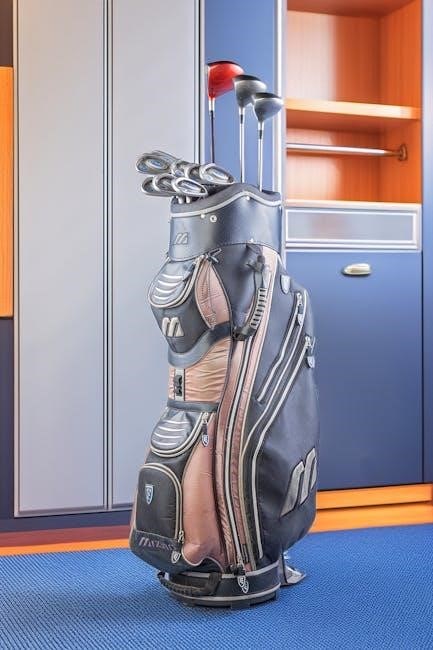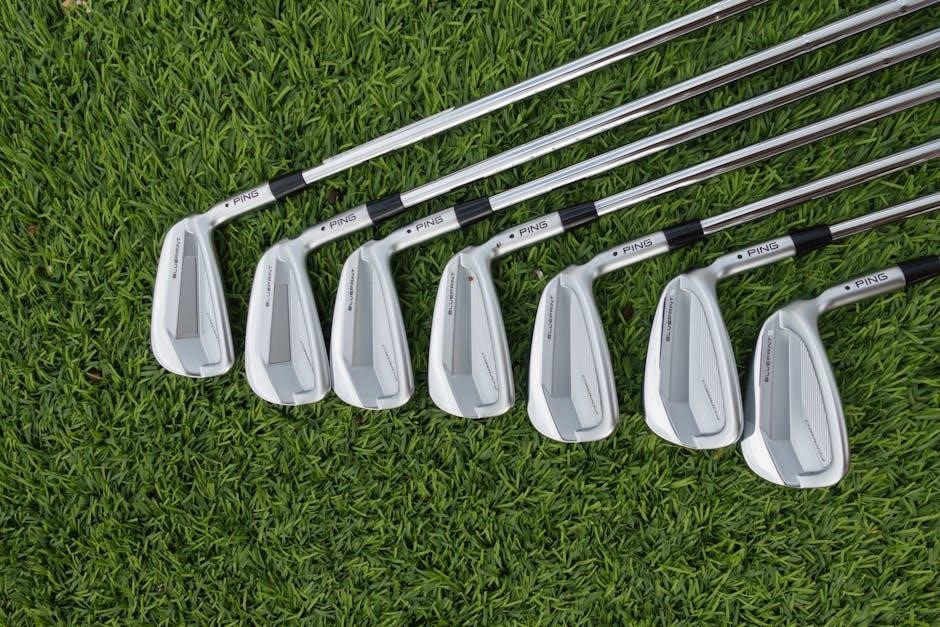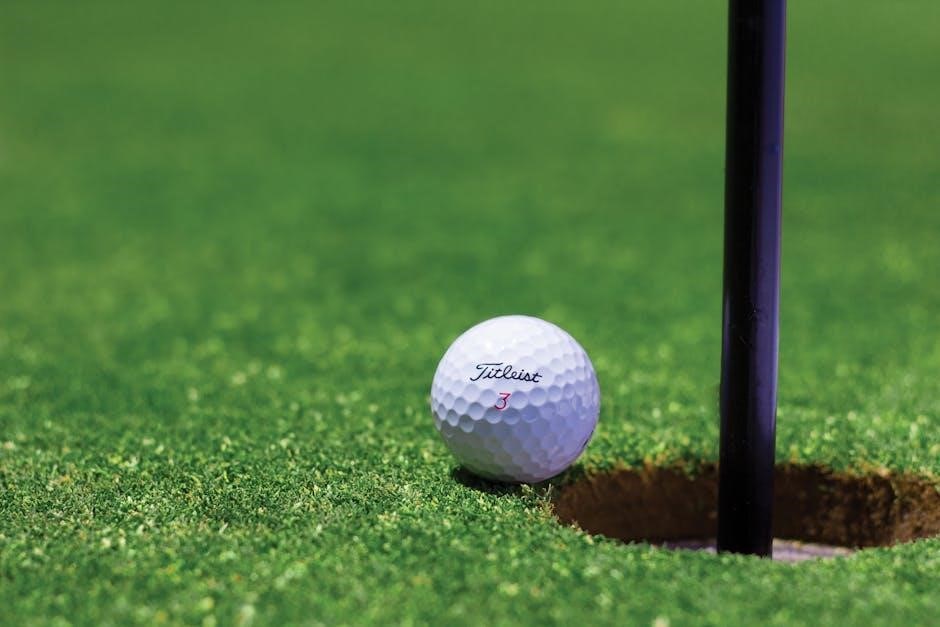Properly sizing junior golf clubs is essential for young players to develop a consistent swing and avoid injuries. Clubs designed for kids vary by age‚ height‚ and skill level‚ ensuring a perfect fit. With brands like US Kids Golf and Golphin offering tailored systems‚ parents and coaches can guide juniors toward the right equipment. This guide explores the importance of proper sizing‚ measurement techniques‚ and how to choose the best clubs for growing golfers.
Why Proper Sizing Matters for Junior Golfers
Properly sized junior golf clubs are crucial for young players to develop a consistent swing and avoid injuries. Ill-fitting clubs can lead to poor posture‚ inconsistent ball striking‚ and discomfort‚ hindering progress. Clubs that are too long or too short force juniors to compensate‚ potentially causing long-term swing issues. Conversely‚ well-fitted clubs promote proper technique‚ better performance‚ and increased confidence. They also prevent fatigue and discomfort‚ keeping the game enjoyable. Ensuring the right size is an investment in a junior’s golf journey‚ fostering skill development and a lifelong love for the sport.
Overview of Junior Golf Club Size Guides
Junior golf club size guides provide structured frameworks to help select appropriate clubs based on a child’s height‚ age‚ and skill level. These guides typically categorize clubs into size ranges‚ such as small‚ medium‚ and large‚ with corresponding height and age recommendations. Many systems‚ like US Kids Golf’s UL system‚ use height as the primary measurement‚ offering clubs in 3-inch increments. Some guides also incorporate color-coding for easy identification. By aligning a child’s measurements with these charts‚ parents and coaches can ensure a proper fit‚ promoting better swing mechanics and overall performance. This approach simplifies the process of choosing the right equipment for young golfers.

Measuring Techniques for Junior Golf Clubs
Measure a junior golfer’s height and wrist-to-floor length using a tape measure to determine the ideal club size. These measurements ensure proper fit and alignment for optimal performance.
Height Measurement for Club Sizing
Height is a critical factor in determining junior golf club size. Measure the child from the ground to the top of their head while wearing golf shoes. This ensures accuracy and consistency. If the child’s height falls between two size ranges‚ opt for the larger size to accommodate growth. Proper height measurement helps select clubs with appropriate shaft lengths‚ promoting a comfortable swing and proper posture. Accurate sizing prevents issues like stooping or reaching‚ which can hinder performance and lead to poor technique. This step is foundational for a well-fitted set of junior golf clubs.
Wrist-to-Floor Measurement: Importance and Method
The wrist-to-floor measurement is another vital tool in sizing junior golf clubs. To measure‚ have the child stand straight with arms relaxed by their sides. Measure from the floor to the base of their wrist. This determines club length adjustments‚ especially for taller or shorter players. For example‚ a wrist-to-floor measurement of 40-41 inches may require a longer club. This method ensures the clubs are proportionate to the child’s body‚ promoting a natural swing. Accurate measurements prevent issues like clubs being too long or short‚ which can affect performance and comfort. This step complements height measurements for optimal fit.

The US Kids Golf Sizing System
US Kids Golf offers a height-based sizing system‚ UL (Ultralight)‚ designed for juniors. Clubs are sized in 3-inch increments‚ catering to children from 39 to 63 inches tall‚ ensuring proper fit and performance as they grow and improve their skills.
Height-Based Sizing: UL (Ultralight) System
The US Kids Golf UL (Ultralight) system uses height as the primary measurement for sizing junior clubs. Designed for children from 39 to 63 inches tall‚ clubs are available in 3-inch increments. This system ensures proper fit and swing mechanics‚ allowing juniors to maintain consistent form as they grow. The UL system is lightweight‚ promoting ease of use and better performance. It accommodates growth spurts‚ reducing the need for frequent upgrades. By matching club length to the child’s height‚ the UL system helps juniors develop a strong foundation in their golf game‚ fostering confidence and skill development at every stage.
Club Length Increments and Growth Accommodation
Junior golf clubs are designed in length increments to accommodate growth and skill development. Typically‚ clubs increase by 1-2 inches per size range‚ allowing for a smooth transition as juniors grow taller and stronger. Many sets are adjustable‚ enabling parents to extend club length without replacing the entire set. This feature not only saves costs but also ensures that young golfers always have appropriately sized equipment. Growth accommodations in club design help maintain proper swing mechanics‚ preventing technical issues that can arise from ill-fitting clubs. This adaptability supports long-term development‚ making junior golf more accessible and enjoyable for children of all ages and skill levels.

Junior Golf Club Sizing Charts
Junior golf club sizing charts provide essential guidance‚ correlating age‚ height‚ and club length to ensure proper fit. These charts help prevent mis-sizing‚ promoting consistent swing mechanics and better performance.
Age-Based Sizing Chart for Junior Golfers
An age-based sizing chart is a practical tool for selecting junior golf clubs‚ offering recommendations tailored to the typical growth stages of young golfers. For example‚ children aged 5-7 years typically use smaller clubs designed for shorter swings and lighter weights‚ while those aged 9-11 years require clubs that accommodate their increasing strength and technique. These charts often categorize club sizes into groups such as Small‚ Medium‚ and Large‚ corresponding to specific age ranges. By aligning club size with age‚ juniors can maintain proper form and enjoy a more comfortable‚ effective golfing experience as they grow and develop their skills.
Height-to-Club-Length Conversion Chart
A height-to-club-length conversion chart is a valuable resource for determining the ideal club length for junior golfers based on their height. This chart typically provides a range of heights and correlates them with specific club lengths‚ ensuring a proper fit. For instance‚ a child measuring 48-51 inches tall might use clubs with a length of 33.50-35.00 inches for a driver. By aligning height with club length‚ juniors can maintain proper posture and swing mechanics‚ promoting consistency and reducing the risk of injury. This tool is especially useful for parents and coaches seeking to equip young golfers with appropriately sized equipment as they grow and develop their skills.
Color-Coded Size Guide for Junior Clubs
A color-coded size guide is a popular method for determining the appropriate junior golf club size. Brands like Golphin and US Kids Golf use vibrant colors to categorize club sets based on age‚ height‚ and skill level. For example‚ Golphin’s GFK system uses colors like Yellow (50-56″)‚ Orange (56-63″)‚ and Red (63-68″) to represent different size ranges. Similarly‚ US Kids Golf assigns colors to specific height groups‚ ensuring a visually intuitive selection process; This system simplifies the fitting process for parents and coaches‚ making it easier to match young golfers with clubs that promote proper swing mechanics and comfort. Each color corresponds to a tailored set of clubs‚ ensuring a perfect fit for growing players.

Factors Influencing Junior Club Size
Key factors influencing junior club size include height‚ age‚ swing speed‚ skill level‚ and grip size‚ each crucial for ensuring proper fit and optimal performance for young golfers.
Age and Skill Level Considerations
Age and skill level significantly influence junior golf club sizing. Younger players typically require shorter‚ lighter clubs to manage swing mechanics effectively. As juniors grow and develop their skills‚ clubs are gradually lengthened and weighted to match their strength and technique. Beginners often benefit from oversized heads and flexible shafts for forgiveness‚ while more advanced players may prefer clubs with lower loft angles and faster swing speeds. Coaches and parents should assess a child’s ability to maintain consistent swing tempo and ball-striking before upgrading to more advanced clubs. Proper fitting ensures optimal performance and supports skill development at every stage of a junior’s golf journey.
Grip Size and Its Impact on Performance
Grip size is a critical factor in junior golf club sizing‚ as it directly affects a player’s ability to control the club. A grip that is too small can cause the club to slip during the swing‚ while a grip that is too large can hinder proper hand rotation and control. Junior grips are typically smaller in diameter‚ ranging from 0.50″ for younger players to 0.75″ for teenagers. Proper grip sizing ensures a consistent hold‚ allowing for better accuracy and power; Coaches often recommend oversize grips for younger players to help them maintain control and develop a proper swing technique from an early age.
Swing Speed and Club Weight Recommendations
Swing speed and club weight are vital considerations for junior golfers. Lighter clubs‚ such as those in the US Kids Golf UL (Ultralight) series‚ are designed for younger players with slower swing speeds‚ promoting better control and technique. Heavier clubs may suit older juniors with faster swing speeds‚ but proper fitting is essential to avoid hindering performance. Club weight should balance with the player’s strength and swing tempo to prevent fatigue and injury. Coaches often recommend lighter clubs for beginners to focus on form and speed development. Matching the right club weight to a junior’s swing speed ensures optimal performance and enhances their overall golfing experience.

Choosing the Right Junior Golf Club Set
Selecting the right junior golf club set involves considering age‚ height‚ and skill level. Sets are tailored for specific developmental stages‚ ensuring proper fit and performance.
Understanding Club Sets for Different Age Groups
Junior golf club sets are designed to cater to specific age groups‚ ensuring clubs match the developmental needs of young players. For younger children (5-7 years)‚ sets typically include fewer clubs with shorter shafts and lighter weights. As juniors grow (8-10 years)‚ sets expand to include more clubs with slightly longer lengths. Teenagers (11+ years) often use clubs closer to adult sizes but with junior flex shafts. Brands like US Kids Golf and Golphin offer age-specific sets‚ making it easier for parents to choose the right equipment. These sets are tailored to promote proper swing mechanics and gradual skill development as juniors grow and improve.
Key Clubs Included in Junior Sets
Junior golf club sets typically include a driver‚ fairway wood‚ hybrid‚ irons‚ wedges‚ and a putter‚ scaled down to suit younger players. These clubs are designed with shorter shafts and lighter weights to promote proper swing mechanics. For younger ages (5-7)‚ sets often include fewer clubs‚ focusing on essentials like a driver‚ 7-iron‚ and putter. As players grow (8-12+)‚ sets expand to include more clubs‚ such as a sand wedge and additional irons. The selection ensures juniors can develop a full range of shots while using equipment tailored to their strength and skill level‚ fostering confidence and improvement in their game.

Top Brands and Their Sizing Systems
Top brands like US Kids Golf and Golphin offer innovative sizing systems. US Kids uses height-based UL sizing with 3-inch increments‚ while Golphin GFK clubs are lightweight for juniors.

US Kids Golf Club Sizing and Features
US Kids Golf pioneered height-based sizing with their UL (Ultralight) system‚ catering to juniors from 39 to 63 inches tall in 3-inch increments. Clubs are lightweight‚ promoting swing speed and control. The color-coded system simplifies size selection‚ while adjustable lengths accommodate growth. US Kids Golf focuses on innovation‚ ensuring juniors can play comfortably and effectively. Their mission is to make golf fun and engaging for kids‚ fostering a lifelong love for the game. With a range of features tailored to young players‚ US Kids Golf stands out as a leader in junior golf equipment.
Golphin GFK Junior Club Sizing and Benefits
Golphin GFK clubs are designed for beginner junior golfers‚ offering a user-friendly sizing system based on age and height. Their size guide categorizes clubs into color-coded sets‚ ensuring an easy match for growing players. The GFK system provides lightweight‚ durable equipment that enhances swing mechanics. Benefits include improved accuracy and distance‚ fostering confidence in young golfers. Golphin’s focus on affordability and quality makes their clubs a popular choice for parents and coaches. By offering adaptable and high-performance tools‚ Golphin helps juniors develop their skills and enjoy the game from an early age.

Tips for Parents and Coaches
Measure your child’s height and wrist-to-floor length to ensure proper club fit. Use size charts to guide your selection and consider growth spurts for future adjustments.
How to Measure Your Child for Clubs
To ensure proper sizing‚ measure your child’s height from the ground to the top of their head while wearing golf shoes. Next‚ measure the wrist-to-floor length by having them stand tall with arms relaxed. Use a size chart to match these measurements to the appropriate club size. If their height falls between sizes‚ consider the next larger size to accommodate growth. Some brands use color-coded systems or height-based charts for easier selection. Accurate measurements are crucial to prevent ill-fitting clubs‚ which can hinder proper technique and comfort. Regularly check and update their club sizes as they grow and develop their skills.
When to Upgrade to the Next Size
Upgrading your child’s golf clubs is necessary when they outgrow their current set‚ typically every 1-2 years. Look for signs such as the clubs being too short or difficult to swing comfortably. If their height exceeds the upper limit of their current size range‚ it’s time to upgrade. Additionally‚ if their swing speed increases significantly or they demonstrate improved skill‚ larger clubs may be needed for better performance. Always refer to the manufacturer’s size chart and consider future growth by selecting clubs with adjustable lengths or choosing the next size up to accommodate development.

Using Junior Golf Club Size Charts Effectively
Align your child’s height with recommended club lengths to ensure proper fit and technique. Measure accurately and refer to charts for ideal sizing‚ considering growth potential.
Matching Height to Club Length
Accurate height-to-club-length matching ensures optimal performance and comfort for junior golfers. Measure your child’s height and refer to sizing charts to find the ideal club length. For example‚ a child measuring 48-52 inches tall typically uses clubs designed for that height range. The US Kids Golf UL system categorizes clubs in 3-inch increments‚ aligning with growth stages. Always consider wrist-to-floor measurement as a secondary factor to refine fit. If between sizes‚ opt for the next size up to accommodate growth. Proper alignment ensures a consistent swing and avoids technique issues‚ making it easier for juniors to enjoy and improve their game.
Adjusting for Growth and Skill Development
As juniors grow and improve‚ their clubs must adapt to maintain proper fit and performance. Regularly assess height‚ swing mechanics‚ and skill level to determine if an upgrade is needed. Many systems‚ like US Kids Golf‚ offer clubs in incremental sizes to accommodate growth spurts. Consider the wrist-to-floor measurement and club length to ensure the set remains suitable. Additionally‚ lighter clubs with adjustable features can help transitioning players without frequent purchases. Monitoring progress ensures juniors stay comfortable‚ fostering consistent improvement and a lifelong enjoyment of the game. Adjustments should be made annually or as growth dictates‚ keeping the equipment aligned with the player’s needs.
Properly fitting junior golf clubs are crucial for skill development and enjoyment. Regular adjustments ensure comfort and performance as young golfers grow and improve their game.
Final Thoughts on Proper Fitting
Properly fitting junior golf clubs are vital for a young player’s performance‚ comfort‚ and enjoyment. Clubs that are too long or short can hinder technique and lead to discomfort. Always consider height‚ wrist-to-floor measurements‚ and growth potential when selecting clubs. The US Kids Golf system‚ which uses height-based sizing‚ is a reliable guide for parents and coaches. Regularly reassessing club fit as children grow ensures ongoing comfort and consistency in their swing. Remember‚ proper fitting fosters confidence and helps prevent injuries‚ allowing juniors to focus on improving their game. Encourage the right fit to nurture a lifelong passion for golf.
Encouraging a Lifelong Love for Golf
Properly fitted junior golf clubs play a significant role in fostering a lifelong passion for the game. When children feel comfortable and confident with their equipment‚ they are more likely to enjoy practicing and playing. Clubs that are too heavy or ill-fitting can lead to frustration and discouragement. Parents and coaches should emphasize the importance of proper sizing while creating a positive and supportive environment for young golfers. Celebrate small achievements and allow children to progress at their own pace. By doing so‚ you help nurture a love for the game that can last a lifetime. Proper fitting ensures fun and engagement‚ key to fostering a lifelong love for golf.

Leave a Reply
You must be logged in to post a comment.